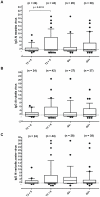Measles IgG antibody index correlates with T2 lesion load on MRI in patients with early multiple sclerosis
- PMID: 22276094
- PMCID: PMC3261854
- DOI: 10.1371/journal.pone.0028094
Measles IgG antibody index correlates with T2 lesion load on MRI in patients with early multiple sclerosis
Abstract
Background: B cells and humoral immune responses play an important role in the pathogenesis and diagnosis of multiple sclerosis (MS). A characteristic finding in patients with MS is a polyspecific intrathecal B cell response against neurotropic viruses, specifically against measles virus, rubella virus, and varicella zoster virus, also known as an MRZ reaction (MRZR). Here, we correlated from the routine clinical diagnostics individual IgG antibody indices (AIs) of MRZR with magnetic resonance imaging (MRI) findings in patients with first MS diagnosis.
Methods/results: MRZR was determined in 68 patients with a clinically isolated syndrome (CIS) or early relapsing-remitting MS (RRMS). Absolute AI values for measles virus, rubella virus, and varicella zoster virus were correlated with T2 lesion load and gadolinium enhancing lesions on cerebral MRI (cMRI) and cMRI combined with spinal MRI (sMRI). Measles virus AI correlated significantly with T2 lesion load on cMRI (p = 0.0312, Mann-Whitney U test) and the sum of lesions on cMRI and sMRI (p = 0.0413). Varicella zoster virus AI also showed a correlation with T2 lesion load on cMRI but did not reach statistical significance (p = 0.2893).
Conclusion: The results confirm MRZR as part of the polyspecific immune reaction in MS with possible prognostic impact on MRI and clinical parameters. Furthermore, the data indicate that intrathecal measles virus IgG production correlates with disease activity on cMRI and sMRI in patients with early MS.
Conflict of interest statement
Figures

Similar articles
-
The MRZ reaction and a quantitative intrathecal IgG synthesis may be helpful to differentiate between primary central nervous system lymphoma and multiple sclerosis.J Neurol. 2018 May;265(5):1106-1114. doi: 10.1007/s00415-018-8779-x. Epub 2018 Mar 6. J Neurol. 2018. PMID: 29511863
-
IgG antibodies against measles, rubella, and varicella zoster virus predict conversion to multiple sclerosis in clinically isolated syndrome.PLoS One. 2009 Nov 5;4(11):e7638. doi: 10.1371/journal.pone.0007638. PLoS One. 2009. PMID: 19890384 Free PMC article.
-
The MRZ reaction as a highly specific marker of multiple sclerosis: re-evaluation and structured review of the literature.J Neurol. 2017 Mar;264(3):453-466. doi: 10.1007/s00415-016-8360-4. Epub 2016 Dec 22. J Neurol. 2017. PMID: 28005176 Review.
-
Polyspecific, antiviral immune response distinguishes multiple sclerosis and neuromyelitis optica.J Neurol Neurosurg Psychiatry. 2008 Oct;79(10):1134-6. doi: 10.1136/jnnp.2007.133330. Epub 2008 Feb 12. J Neurol Neurosurg Psychiatry. 2008. PMID: 18270237
-
Low intrathecal antibody production despite high seroprevalence of Epstein-Barr virus in multiple sclerosis: a review of the literature.J Neurol. 2018 Feb;265(2):239-252. doi: 10.1007/s00415-017-8656-z. Epub 2017 Nov 2. J Neurol. 2018. PMID: 29098417 Review.
Cited by
-
Epidemiology of multiple sclerosis in Qom: Demographic study in Iran.Iran J Neurol. 2013;12(4):136-43. Iran J Neurol. 2013. PMID: 24250923 Free PMC article.
-
Viruses and endogenous retroviruses in multiple sclerosis: From correlation to causation.Acta Neurol Scand. 2017 Dec;136(6):606-616. doi: 10.1111/ane.12775. Epub 2017 May 23. Acta Neurol Scand. 2017. PMID: 28542724 Free PMC article. Review.
-
The MRZ reaction and a quantitative intrathecal IgG synthesis may be helpful to differentiate between primary central nervous system lymphoma and multiple sclerosis.J Neurol. 2018 May;265(5):1106-1114. doi: 10.1007/s00415-018-8779-x. Epub 2018 Mar 6. J Neurol. 2018. PMID: 29511863
-
Intrathecal Antibody Production Against Epstein-Barr, Herpes Simplex, and Other Neurotropic Viruses in Autoimmune Encephalitis.Neurol Neuroimmunol Neuroinflamm. 2021 Aug 24;8(6):e1062. doi: 10.1212/NXI.0000000000001062. Print 2021 Nov. Neurol Neuroimmunol Neuroinflamm. 2021. PMID: 34429365 Free PMC article.
-
Serum IgG levels to Epstein-Barr and measles viruses in patients with multiple sclerosis during natalizumab and interferon beta treatment.BMJ Neurol Open. 2022 Jul 27;4(2):e000271. doi: 10.1136/bmjno-2022-000271. eCollection 2022. BMJ Neurol Open. 2022. PMID: 35978722 Free PMC article.
References
-
- Barkhof F, Filippi M, Miller DH, Scheltens P, Campi A, et al. Comparison of MRI criteria at first presentation to predict conversion to clinically definite multiple sclerosis. Brain. 1997;120:2059–2069. - PubMed
-
- Swanton JK, Rovira A, Tintore M, Altmann DR, Barkhof F, et al. MR1 criteria for multiple sclerosis in patients presenting with clinically isolated syndromes: a multicentre retrospective study. Lancet Neurology. 2007;6:677–686. - PubMed
-
- Felgenhauer K, Reiber H. The Diagnostic-Significance of Antibody Specificity Indexes in Multiple-Sclerosis and Herpes-Virus InducedDiseases of the Nervous-System. Clinical Investigator. 1992;70:28–37. - PubMed
-
- Jarius S, Eichhorn P, Jacobi C, Wildemann B, Wick M, et al. The intrathecal, polyspecific antiviral immune response: Specific for MS or ageneral marker of CNS autoimmunity? Journal of the NeurologicalSciences. 2009;280:98–100. - PubMed
-
- Cepok S, Jacobsen M, Schock S, Omer B, Jaekel S, et al. Patterns of cerebrospinal fluid pathology correlate with disease progression inmultiple sclerosis. Brain. 2001;124:2169–2176. - PubMed
Publication types
MeSH terms
Substances
LinkOut - more resources
Full Text Sources
Medical
Molecular Biology Databases

